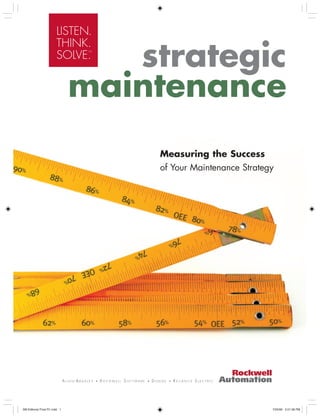The document provides an overview of new products, services, and enhancements from Rockwell Automation related to maintenance. Some highlights include:
- New Ethernet Diagnostic Module and XM vibration modules to monitor equipment health.
- Enhancements to intelligent motor control solutions to simplify maintenance.
- RSMACC change management software adding verification for Rockwell Automation drives.
- Acquisition of GEPA to expand connectivity to third-party devices.
- New training courses and workstations on topics like RSLogix 5000 motion and EtherNet/IP.

































































![66
Today’s globally competitive economy has resulted in
significant shifts in the relationships between producers,fi
suppliers, and consumers. The need for improved
production reliability and reduced expenses is clearly
demonstrated by production strategies such as “just-in-
time” material supply and delivery.
As a manufacturer, to be successful in this environment,
it is vital you optimize your investment in critical
production assets. Simply put, to ensure future growth
you must maximize your Return on Net Assets
[RONA = (Plant Revenue-Costs) / Net Assets].
The Emonitor®
family of products provides you with
a suite of integrated maintenance data functions to
leverage information about your assets. This enables
you to make intelligent, informed decisions that
maximize uptime, reduce inventory, cut production and
maintenance costs, and improve your Overall Equipment
Effectiveness [OEE = Availability x Rate x Quality].
Emonitor software specializes in the analysis and
storage of vibration data. Emonitor can easily diagnose
problems such as bearing wear and unbalance with
its built-in analysis capabilities. Emonitor allows the
vibration analyst to easily diagnose and remedy
complex issues on equipment.
Complete storage and
analysis of vibration data
®
software
Emonitor Plant Wide Asset
Data Integration Functions:
• Asset Register
• Condition Monitoring Capabilities
• Asset Health Analysis/Intelligent Advisory
• Operations and Maintenance Advisories
• Web Client Access
For more information, go to
www.rockwellautomation.com/
services/conditionmonitoring/
emonitor.html
Pd Pv Re
SM Selection Final R1.indd 66SM Selection Final Rn Final R1.ind1.indd 6d 666 7/25/06 3:09:30 PM7/7/2/25/06 3:09:5/5/0/06 3:09:30 PM30 PM](https://image.slidesharecdn.com/442e2256-da7f-4efa-adaa-0099609faa57-160119175811/85/StrategicMaintenance7-28-07-66-320.jpg)

























